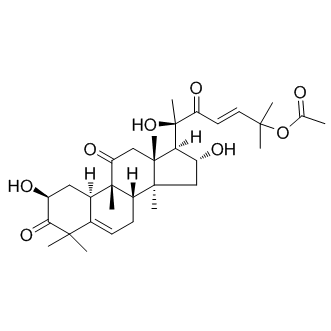| Cas No.: | 6199-67-3 |
| SMILES: | O[C@@H]1C(C(C)(C)C2=CC[C@]([C@@](C[C@@H](O)[C@]3([H])[C@](O)(C)C(/C=C/C(C)(C)OC(C)=O)=O)(C)[C@]3(C)CC4=O)([H])[C@]4(C)[C@]2([H])C1)=O |
| Formula: | C32H46O8 |
| M.Wt: | 558.7 |
| Purity: | >98% |
| Sotrage: | 4°C for 1 year, -20°C for more than 2 years |
| Description: | Cucurbitacin B belongs to a class of highly oxidized tetracyclic triterpenoids; could repress cancer cell progression. |
| Target: | Target: anticancer natural compound |
| In Vivo: | Efficacy of CuB was tested in vivo using two different orthotopic models of breast cancer. MDA-MB-231 and 4T-1 cells were injected orthotopically in the mammary fat pad of female athymic nude mice or BALB/c mice respectively. Our results showed that CuB administration inhibited MDA-MB-231 orthotopic tumors by 55%, and 4T-1 tumors by 40%. The 4T-1 cells represent stage IV breast cancer and form very aggressive tumors [3]. |
| In Vitro: | Cucurbitacin-B inhibited growth and modulated expression of cell-cycle regulators in SHSY5Y cells. At the molecular level, we found that Cucurbitacin-B inhibited AKT signaling activation through up-regulation of PTEN [1]. CuB induced apoptosis of A549 cells in a -concentration-dependent manner, as determined by fluorescence microscopy, flow cytometry and transmission electron microscopy. CuB dose-dependently inhibited lung cancer cell proliferation, with cell cycle inhibition and cyclin B1 downregulation. Apoptosis induced by CuB was shown to be associated with cytochrome c release, B-cell lymphoma 2 downregulation and signal transducer and activator of transcription 3 pathway inhibition [2]. CuB inhibited ITGA6 and ITGB4 (integrin α6 and integrin β4), which are overexpressed in breast cancer. Furthermore, CuB also induced the expression of major ITGB1and ITGB3, which are known to cause integrin-mediated cell death [3]. Cuc B treatment caused DNA double-strand breaks (DSBs) without affecting the signal transducer and activator of transcription 3 (STAT3), the potential molecular target for Cuc B. Cuc B triggers ATM-activated Chk1-Cdc25C-Cdk1, which could be reversed by both ATM siRNA and Chk1 siRNA. Cuc B also triggers ATM-activated p53-14-3-3-σ pathways, which could be reversed by ATM siRNA [4]. |
| References: | [1]. Shang Y, et al. Cucurbitacin-B inhibits neuroblastoma cell proliferation through up-regulation of PTEN. Eur Rev Med Pharmacol Sci. 2014;18(21):3297-303. [2]. Zhang M, et al. Cucurbitacin B inhibits proliferation and induces apoptosis via STAT3 pathway inhibition in A549 lung cancer cells. Mol Med Rep. 2014 Dec;10(6):2905-11. [3]. Gupta P, et al. Inhibition of Integrin-HER2 signaling by Cucurbitacin B leads to in vitro and in vivo breast tumor growth suppression. Oncotarget. 2014 Apr 15;5(7):1812-28. [4]. Guo J, et al. Cucurbitacin B induced ATM-mediated DNA damage causes G2/M cell cycle arrest in a ROS-dependent manner. PLoS One. 2014 Feb 4;9(2):e88140. |

 DC Chemicals' products qualify for U.S. tariff exemptions. We guarantee no price increases due to customs duties and maintain stable supply, continuing to deliver reliable research solutions to our American clients.
DC Chemicals' products qualify for U.S. tariff exemptions. We guarantee no price increases due to customs duties and maintain stable supply, continuing to deliver reliable research solutions to our American clients.





















